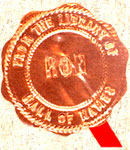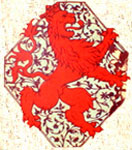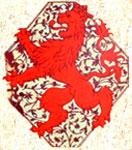|
Home
|
The
Scottish/English border was a tract of rugged border territory stretching
from Carlisle in the west to Berwick in the east. The name Errington is
one of the oldest border surnames or clans.
Ancient manuscripts such as the Exchequer Rolls of Scotland, the Inquisition,
the Ragman Rolls, the Domesday Book, Acts of Scottish Parliaments, baptismals,
parish records and cartularies, and tax records were researched. The name
Errington was first found in Northumberland where they were seated from
very ancient times, some say well before the Norman Conquest and the arrival
of Duke William at Hastings in 1066 A.D.
Although our name, Errington,occurred in many references, from time to
time, the surname was shown with the spellings Errington, Erringden, Erington,
and these changes in spelling frequently occurred during a person's own
lifetime, or between father and son. Simple errors by scribes and church
officials occurred when they spelt the name as it sounded. The same person
was often born with one spelling, married with another, and on his gravestone,
yet another.
The family name Errington is believed to be descended originally from
the Boernicians. This ancient, founding race of the north were
a mixture of Scottish Picts, Angles and Vikings, a race dating from about
the year 400 A.D.
Their territories ranged from Edinburgh in the north, southward to the
North Riding of Yorkshire in England. From 400A.D. to 900A.D., their territory
was overrun firstly by the Ancient Britons, then the Angles from the south,
and,finally
the Vikings, Picts and Dalriadans from the north. By 1000 A.D., however,
the race had formed into discernible Clans and families, perhaps some
of the first evidence of the family structure in Britain. This area produced
strange nicknames such as the Sturdy Armstrongs, one of whom, Neil, was
the first to colonize the moon, the Gallant Grahams, the Saucy Scotts,
the Angry Kerrs, the Bells, the Nixons, the Famous Dixons, the Bold Rutherfords,
the Pudding Somervilles, and most of the names ending in 'sons'.
Emerging from this distinguished circle is the surname Errington and the
earliest records were found in Northumberland where they were recorded
as a family of great antiquity seated at Errington with manor and estates
in the shire. They later branched to Beaufront in that same shire and
to Walwich Orange and High Warden. By the 13th century a branch had moved
south to Hele in Wiltshire, Chadwell Hall and Lexden Park in Essex, and
Ashbourne in Derbyshire. They also acquired Sandham House in Northumberland,
and Clintz inYorkshire. In Cheshire the family intermarried with the notable
Stanleys, Lords of Mann, and aquired estates at Hooton in that shire.
Notable amongst the family name during the early history was Sir William
Errington.
The clans or families to the north of the border became Scottish after
the year 1000, and to the south they became English. However they would
continue to be united clans, powers unto themselves, owing little allegiance
to either Scotland or England, having territories and interests on both
sides of the border.
Conflict between these aggressive families became so great that in 1246
A.D., 6 chiefs from the Scottish side and 6 chiefs from the English side
met at Carlisle and produced a set of laws for all the border territory.
These were unlike any laws prevailing in England and Scotland or, for
that matter, anywhere else in the world. For example, it was a far greater
offence to refuse to help a neighbour recover his property, wife, sheep,
cattle or horses than it was to steal them in the first place. For refusal
of assistance a person could be hanged on the instant, without a trial.
While clans were on this 'hot trod', from which we get the modern expression
'hot to trot', they were protected from almost all eventualities. Many
of the descendants of this border area have enjoyed the distinction of
claiming to be descended from cattle thieves and horse stealers, little
realizing this was the way of life amongst the border people who, ironically
earned nicknames such as the Haughty Humes, the Worthy Watsons, the Proud
Setons and the Jingling Jardines.
In 1603, unification of the crowns of England and Scotland under James
the VI of Scotland found it expedient to disperse the 'unruly border clans'.
In 1587, an act of Scottish Parliament had condemned certain border families
for their lawlessness. Scotland was moving toward breaking up the old
'border code'.
Hence, the Border Clans, largely the Strathclyde Britons on the western
border, and the Boernicians on the Eastern Border Marches, were dispersed
to England, northern Scotland and to Ireland. Some were banished directly
to the Colonies.
In Ireland, they were granted lands previously held by the Catholic Irish.
They signed an 'undertaking' to remain protestant and faithful to the
Crown. There is no evidence that the family migrated to Ireland, but this
does not preclude the possibility of their scattered migration to that
country.
Gradually becoming disenchanted with life in Ireland many of these uprooted
families sailed aboard the armada of sailing ships known as the 'White
Sails' which plied the stormy Atlantic. These overcrowded ships often
arrived with only 60 to 70% of their original passenger list, many dying
of cholera, typhoid, dysentery or small pox.
In North America, some of the first migrants which could be considered
kinsmen of the family name Errington, of that same clan or family, were
Abraham Errington who settled in Charleston Mass. in 1630 ; Thomas Errington
settled in Salem Mass.in1635 ; Richard Errington settled in Virginia in
1642.
These migrants became the backbone of the first settlements from Maine
to Cumberland Gap. In Canada they settled in Nova Scotia, the St Lawrence
and the Ottawa Valley. During the American War of Independence those loyal
to the Crown moved northward into Canada and became known as the United
Empire Loyalists.
Meanwhile, the family name Errington provided many prominent contemporaries,
Viscount Errington ; Colonel Sir Geoffrey Errington; Lancelot Errington,
Secretary of Health ; Richard Errington, Accountant. Also Juliet Errington
the famous Sky reporter 2005.The most ancient grant of a Coat of Arms
found was ; Silver with two horizontal blue bars and at the top three
blue shellfish.
The crest is ; A red cock.
 ..................................... .....................................
God
Send Grace......................................................................
~~~~~~~~~~~~~~~~~~~~~~~~~~~~~~~~
~~~~~~~~~~~~~~~~~~~~~~~~~~~~
|
|



